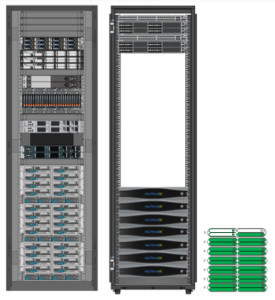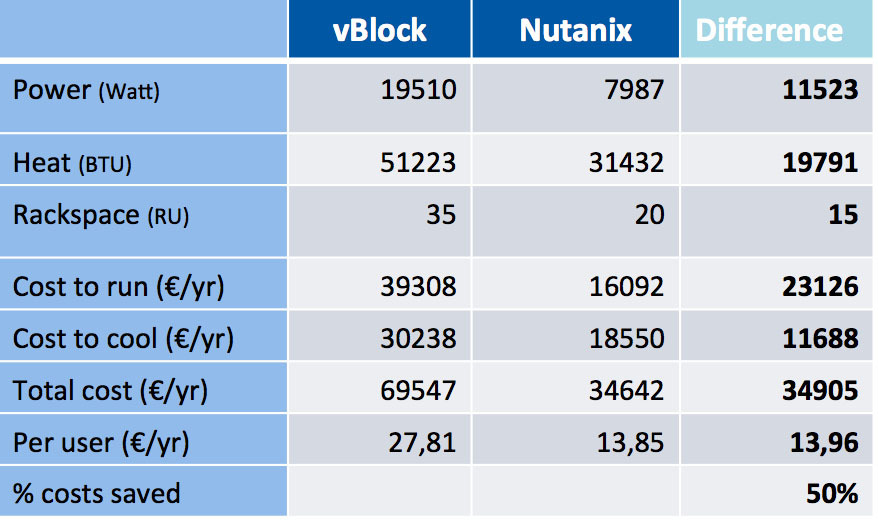Cost Effective Nutanix Solution

Dutch partner Nutanix published in his blog interesting calculations comparing the cost-effectiveness of classic solutions, or “convergent 1.0”, such as VCE / EMC vBlock, Cisco / NetApp FlexPod, and EMC VSPEX, taking their reference architectures (CVS, Citrix Validated Solutions) under VDI using XenDesktop, and repeating them on Nutanix. Nutanix also has this document: Citrix Validated Solution for Nutanix .
It is not difficult to do this, especially since Nutanix laid out its saiser for open access, which was made possible by the fact that Nutanix’s VDI load formulas are relatively simple, which is also due to its architecture.
Here is the calculation process.
When sizing, you can assume that a single computational node (node) of the 3000 series has a load of 110 VDI VM or 200 HSD (the so-called XenApp) users. Accordingly, in the case of a full 2U block with 4 nodes, this will be 440 VDI VM XenDesktop and 800 XenApp users. Further growth is linear with a step on one node.
')
In the first two nodes of the system, we will place the virtual machines of the infrastructure of the project.
The figure shows two options, the first for XenApp, the second for VDI.


It can be assumed that the load profile characteristics of all vendors are approximately equal, since all designs were evaluated for performance using the LoginVSI : Medium Workload benchmark .
The cost of electricity in the calculation was taken to be equal to the average for industrial consumers in the Netherlands ( 0.23 Euro per kWh ), where the author wrote this comparison. For Russia and possible other values of the cost of electricity, only absolute indicators in money will change, but the relative value of savings will remain. By the way, who owns the information, tell me in the comments, what price per kilowatt should be taken for calculation in a data center in the Moscow region?
Electricity consumption and heat dissipation are taken from vendor materials and reference architecture specified in the description, as well as from orline calculators, such as the Cisco UCS power calculator, and are taken as a typical value, or taken as 75%, if only the peak value is indicated.
The cost for the desktop is calculated based on the total cost of the infrastructure, as brokers, switches and other components are necessary for the work of the desktops.
The method for calculating cooling costs is taken from this Edwin Weijdema publication . According to his calculations, in order to utilize 1000 BTU per hour, you need to spend 293 Watt / h for cooling. We take his methodology for an approximate and use its results.
Versions of XenDesktop may be slightly different (for example, versions 7.1 and 7.5 were used in different architectures. Hypervisors could also be different, in the case of Nutanix we used Hyper-V, in other architectures we used VMware vSphere.
Nutanix vs vce vblock
Let's start with the volume occupied by the solution, the so-called footprint. VCE vBLOCK versus Nutanix for a 100% XenDesktop VDI system for 2500 desktops. Take the reference design VCE here .
Below is a picture of the placement in the rack of both solutions.

The VCE vBlock on the 2500 VDI XenDesktop occupies an almost full cabinet (35U of cabinet capacity 42U), while the Nutanix solution uses 20U in it. According to the calculations, we will need 25 nodes in the cluster, and, as you can see in the diagram, you are using only one node in the top block. 6U at the top of the cabinet are Arista switches (2x 48-port Gigabit switch and 4x 24-port 10G switch) providing the necessary switching infrastructure of the cluster.
Since the vBlock design uses Provisioning Services and 4 PVS servers, we removed the desktops from the first two nodes to accommodate 4 additional PVS servers. This means that 2500 desktops run on 23 nodes (a total of 2,530 desktops).
Now let's look at the calculations:

The calculation shows us that vBlock costs us at 69547 Euro per year the cost of its operation (only power consumption and cooling, excluding administration and maintenance costs), based on 75% of the load. Compared to him, the cost of operating a Nutanix solution costs about half the same price of a VCE vBlock. Calculating the cost of the desktop gives us 27.81 Euro per year for the desktop on vBlock, and only 13.85 Euro per year for Nutanix. The total savings is 50% .
Nutanix vs NetApp / Cisco Flexpod
Now let's compare Nutanix with another solution, take the Cisco / NetApp reference design, which can be viewed here , made for 2000 users, 75% work in XenApp and 25% in VDI.
Occupied closet space:

Again, we see a significant difference in the occupied space. FlexPod is better than vBlock in terms of space, but still worse than Nutanix, 30U versus 11U for Nutanix. Nutanix uses 4 blocks, with only 2 nodes installed in the upper one. On 2 infrastructure nodes, there are 100 XenApp users on each, so we need about 9 nodes for 1500 users in XenApp, and another 5 for VDI users. We slightly exceeded the results on the desktop with the original design, by 100 XenApp users, and by 50 VDI, but this excess simplified our further calculations, and “more - no less” :).
Results:

The results speak for themselves. 60% cost reduction per year, with a desktop price of 9.49 Euro per year . Get a price for a desktop below 10 euros per year allowed the use of the Flexcast model in the Hosted Shared Desktop (XenApp), which allows you to be placed denser than when using VDI, while “less equipment” means “less cost”.
Finally, the third comparison.
Nutanix vs Cisco UCS B bladeserver + EMC VSPEX
Compare Nutanix with the Cisco + EMC VSPEX design . This is a design for 1000 users, divided in a 70% / 30% ratio between HSD XenApp and VDI. Our rack volume was about 50% less for comparison with FlexPod, a “convergent solution v1.0,” and here we see how fatally inefficient the use of the classic storage system and the traditional server + storage solution looks like for the desktop virtualization task:

Based on our CVS (Citrix Validated Solution), we only needed 7 nodes for 750 HSD and 250 VDI users, which took us only 4U for Nutanix in the rack, plus 3U for switches at the top of the rack.
Here is the result:

70% cost savings, or 25654 Euro per year , with a desktop price of 11.23 Euro per year . Saving space in the closet at the same time - 80% .
findings
It was not a big surprise that the hyperconvergent infrastructure gives us a significantly smaller footprint, that is, the space occupied in the datacenter rack by your infrastructure. But you don't just take up less rack space using Nutanix. Less are the costs of power supply, as well as cooling. Many traditional solutions require large amounts of power supply, which sometimes is simply impossible in some data centers, and even if these additional resources are available, their use can cost a very large amount of additional costs per year compared to the Nutanix solution.
And then, perhaps, this picture for some VCE vBlock clients will be prophetic. :)

List of materials used:
Citrix Validated Solution for Nutanix
VBlock Specialized System for Extreme Applications with Citrix XenDesktop 7.1
Flexpod Datacenter with Citrix XenDesktop 7.1 and VMware vSphere 5.1
Cisco Desktop Virtualization Solution for EMC VSPEX with Citrix XenDesktop 7.5 for 1000 seats
Cisco UCS Power Calculator
Blog Edwin Weijdema: How to calculate costs for power and cooling
EMC XtremIO System Specifications
EMC VNXe Series Specifications
EMC VNX Series Specifications
Arista 7048-A Datasheet
Netapp Site Requirements Guide
Nutanix spec sheet
Source http://www.nutinus.nl/?p=51
Source: https://habr.com/ru/post/244237/
All Articles